HRM 11120: Leading Strategic Decision Making at Unilever Report
VerifiedAdded on 2023/06/09
|10
|2755
|410
Report
AI Summary
This report analyzes Unilever's strategic decision-making processes, focusing on the application of Porter's Generic Competitive Strategies framework. It begins with an introduction to strategic decision-making and its importance in business, specifically in the context of Unilever, a multinational consumer goods company. The report then applies Porter's framework to analyze Unilever's business strategy, with a particular emphasis on its broad differentiation strategy. It critically evaluates the advantages and limitations of this approach, considering aspects like high pricing and a limited customer base. Finally, the report offers recommendations to overcome these limitations, such as finding new channels to reduce input costs and expand the customer base. The analysis highlights Unilever's competitive advantages and provides insights into how it can refine its strategies for sustained success.
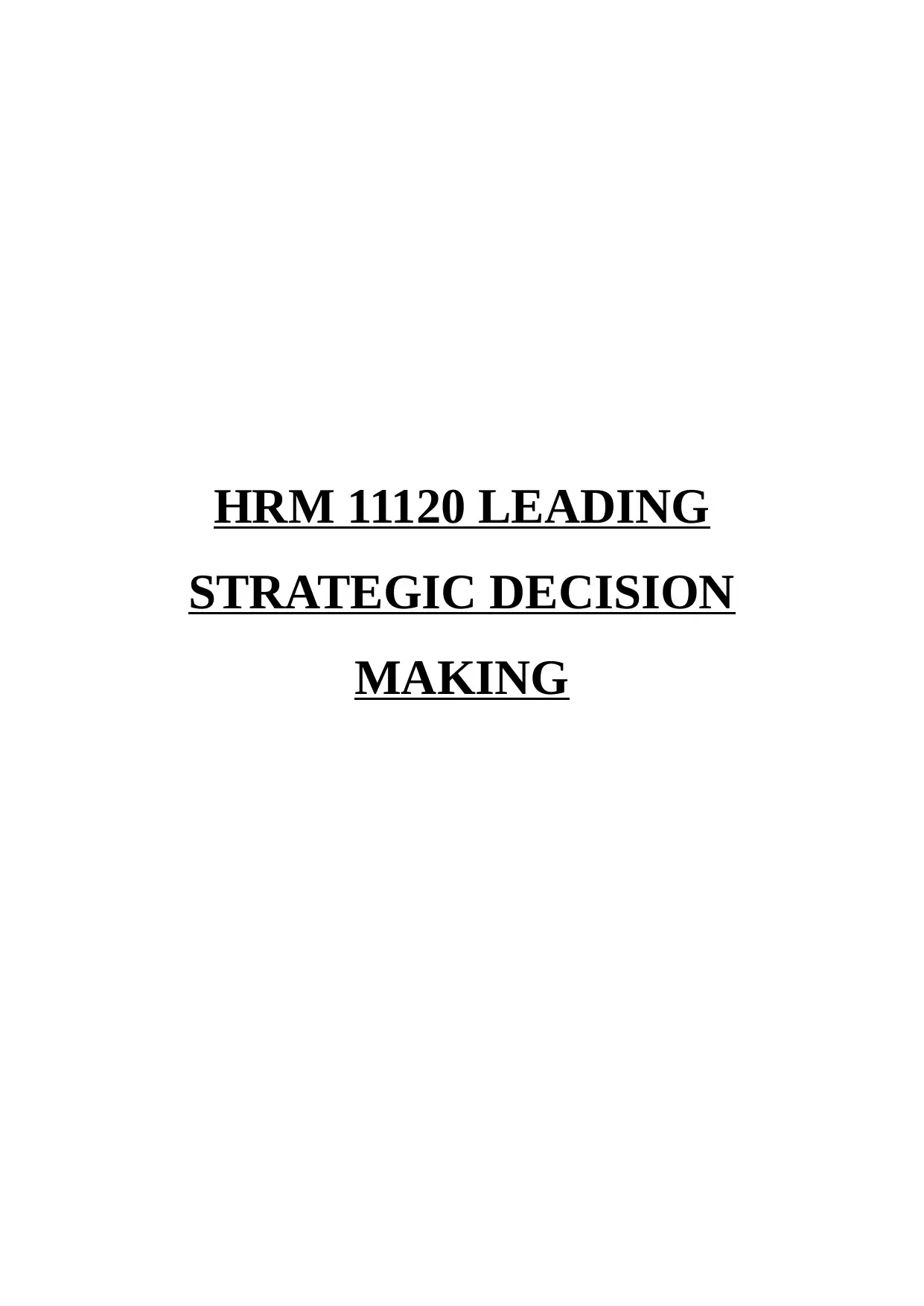
HRM 11120 LEADING
STRATEGIC DECISION
MAKING
STRATEGIC DECISION
MAKING
Paraphrase This Document
Need a fresh take? Get an instant paraphrase of this document with our AI Paraphraser
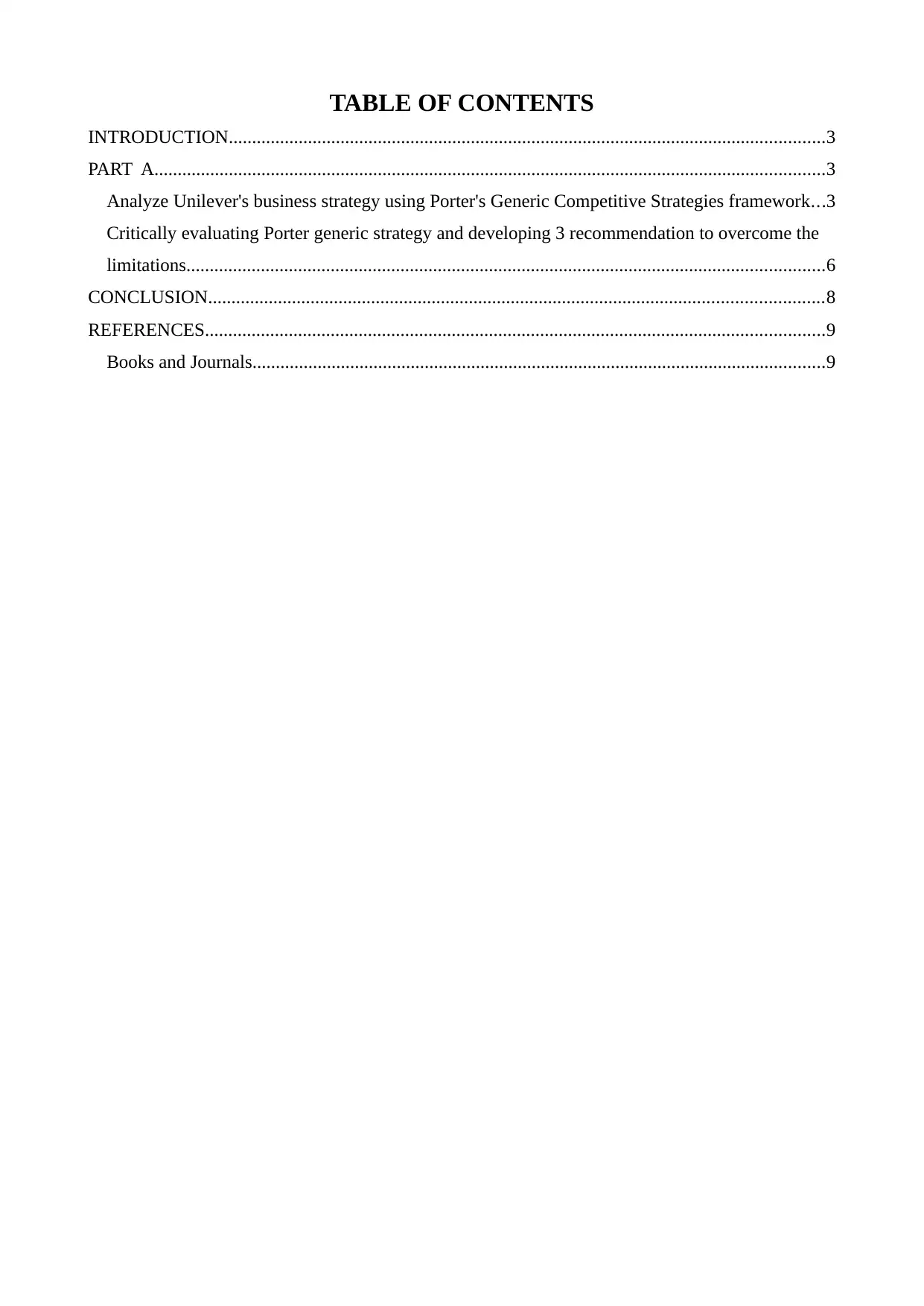
TABLE OF CONTENTS
INTRODUCTION................................................................................................................................3
PART A................................................................................................................................................3
Analyze Unilever's business strategy using Porter's Generic Competitive Strategies framework...3
Critically evaluating Porter generic strategy and developing 3 recommendation to overcome the
limitations.........................................................................................................................................6
CONCLUSION....................................................................................................................................8
REFERENCES.....................................................................................................................................9
Books and Journals...........................................................................................................................9
INTRODUCTION................................................................................................................................3
PART A................................................................................................................................................3
Analyze Unilever's business strategy using Porter's Generic Competitive Strategies framework...3
Critically evaluating Porter generic strategy and developing 3 recommendation to overcome the
limitations.........................................................................................................................................6
CONCLUSION....................................................................................................................................8
REFERENCES.....................................................................................................................................9
Books and Journals...........................................................................................................................9
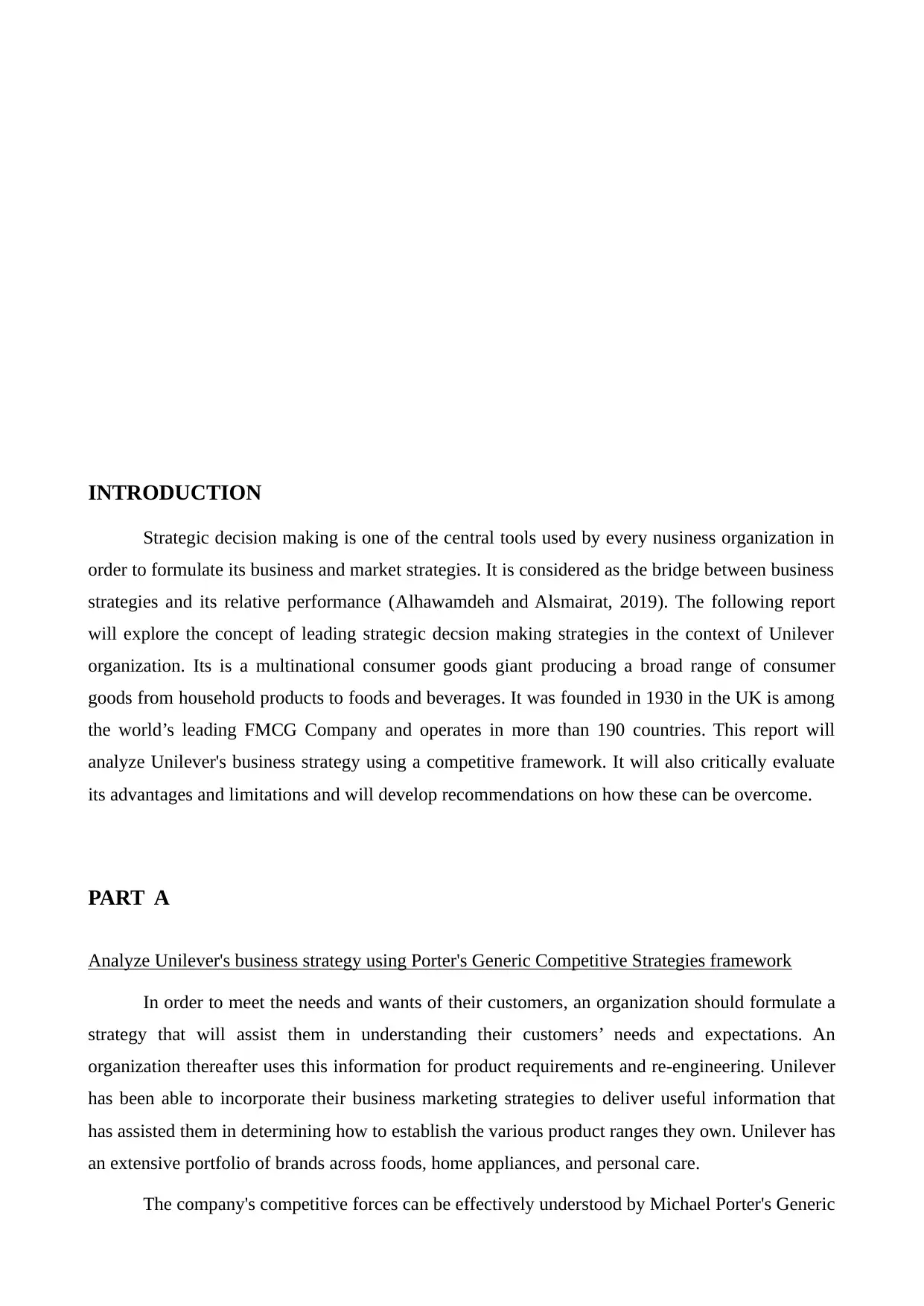
INTRODUCTION
Strategic decision making is one of the central tools used by every nusiness organization in
order to formulate its business and market strategies. It is considered as the bridge between business
strategies and its relative performance (Alhawamdeh and Alsmairat, 2019). The following report
will explore the concept of leading strategic decsion making strategies in the context of Unilever
organization. Its is a multinational consumer goods giant producing a broad range of consumer
goods from household products to foods and beverages. It was founded in 1930 in the UK is among
the world’s leading FMCG Company and operates in more than 190 countries. This report will
analyze Unilever's business strategy using a competitive framework. It will also critically evaluate
its advantages and limitations and will develop recommendations on how these can be overcome.
PART A
Analyze Unilever's business strategy using Porter's Generic Competitive Strategies framework
In order to meet the needs and wants of their customers, an organization should formulate a
strategy that will assist them in understanding their customers’ needs and expectations. An
organization thereafter uses this information for product requirements and re-engineering. Unilever
has been able to incorporate their business marketing strategies to deliver useful information that
has assisted them in determining how to establish the various product ranges they own. Unilever has
an extensive portfolio of brands across foods, home appliances, and personal care.
The company's competitive forces can be effectively understood by Michael Porter's Generic
Strategic decision making is one of the central tools used by every nusiness organization in
order to formulate its business and market strategies. It is considered as the bridge between business
strategies and its relative performance (Alhawamdeh and Alsmairat, 2019). The following report
will explore the concept of leading strategic decsion making strategies in the context of Unilever
organization. Its is a multinational consumer goods giant producing a broad range of consumer
goods from household products to foods and beverages. It was founded in 1930 in the UK is among
the world’s leading FMCG Company and operates in more than 190 countries. This report will
analyze Unilever's business strategy using a competitive framework. It will also critically evaluate
its advantages and limitations and will develop recommendations on how these can be overcome.
PART A
Analyze Unilever's business strategy using Porter's Generic Competitive Strategies framework
In order to meet the needs and wants of their customers, an organization should formulate a
strategy that will assist them in understanding their customers’ needs and expectations. An
organization thereafter uses this information for product requirements and re-engineering. Unilever
has been able to incorporate their business marketing strategies to deliver useful information that
has assisted them in determining how to establish the various product ranges they own. Unilever has
an extensive portfolio of brands across foods, home appliances, and personal care.
The company's competitive forces can be effectively understood by Michael Porter's Generic
⊘ This is a preview!⊘
Do you want full access?
Subscribe today to unlock all pages.

Trusted by 1+ million students worldwide
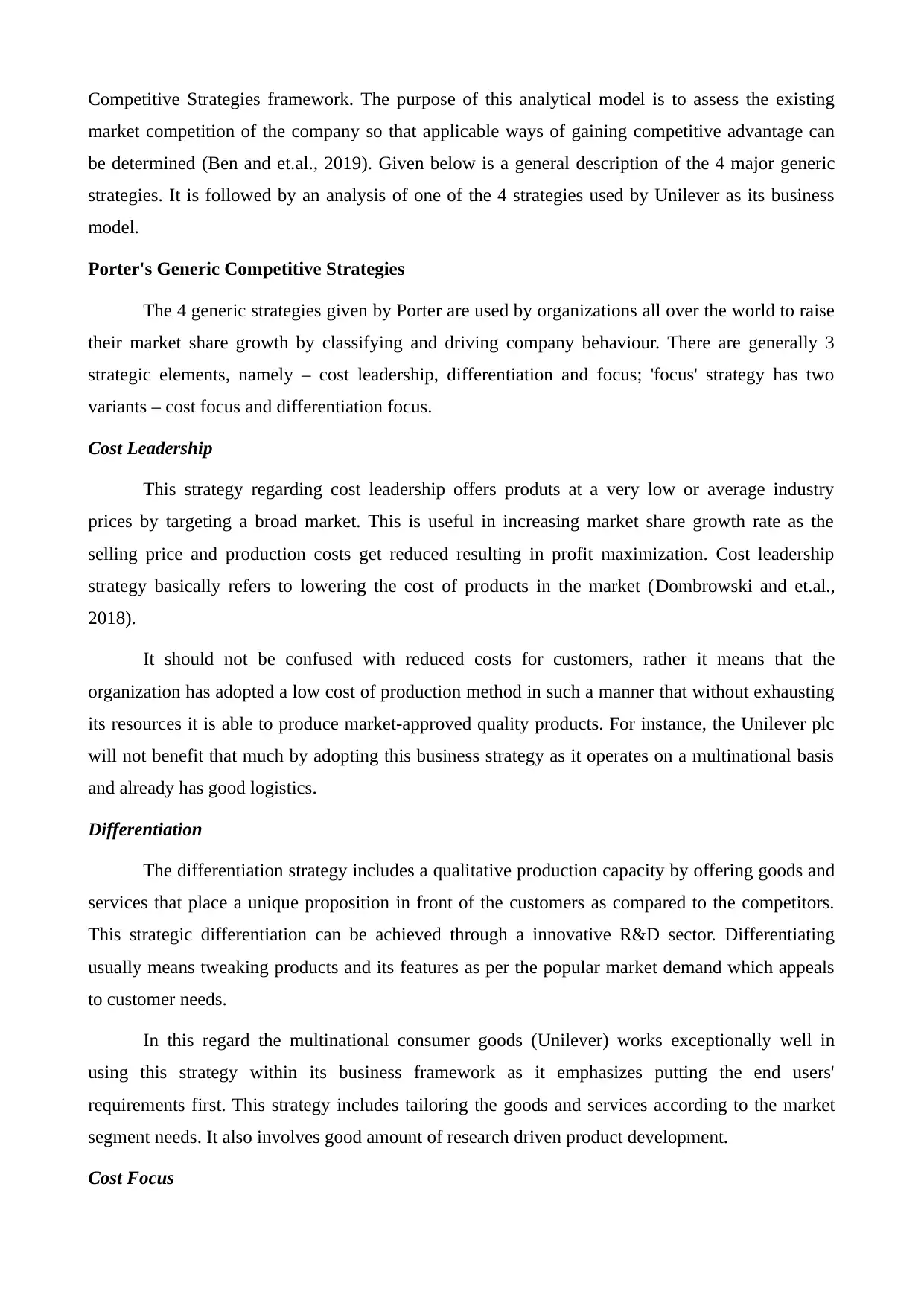
Competitive Strategies framework. The purpose of this analytical model is to assess the existing
market competition of the company so that applicable ways of gaining competitive advantage can
be determined (Ben and et.al., 2019). Given below is a general description of the 4 major generic
strategies. It is followed by an analysis of one of the 4 strategies used by Unilever as its business
model.
Porter's Generic Competitive Strategies
The 4 generic strategies given by Porter are used by organizations all over the world to raise
their market share growth by classifying and driving company behaviour. There are generally 3
strategic elements, namely – cost leadership, differentiation and focus; 'focus' strategy has two
variants – cost focus and differentiation focus.
Cost Leadership
This strategy regarding cost leadership offers produts at a very low or average industry
prices by targeting a broad market. This is useful in increasing market share growth rate as the
selling price and production costs get reduced resulting in profit maximization. Cost leadership
strategy basically refers to lowering the cost of products in the market (Dombrowski and et.al.,
2018).
It should not be confused with reduced costs for customers, rather it means that the
organization has adopted a low cost of production method in such a manner that without exhausting
its resources it is able to produce market-approved quality products. For instance, the Unilever plc
will not benefit that much by adopting this business strategy as it operates on a multinational basis
and already has good logistics.
Differentiation
The differentiation strategy includes a qualitative production capacity by offering goods and
services that place a unique proposition in front of the customers as compared to the competitors.
This strategic differentiation can be achieved through a innovative R&D sector. Differentiating
usually means tweaking products and its features as per the popular market demand which appeals
to customer needs.
In this regard the multinational consumer goods (Unilever) works exceptionally well in
using this strategy within its business framework as it emphasizes putting the end users'
requirements first. This strategy includes tailoring the goods and services according to the market
segment needs. It also involves good amount of research driven product development.
Cost Focus
market competition of the company so that applicable ways of gaining competitive advantage can
be determined (Ben and et.al., 2019). Given below is a general description of the 4 major generic
strategies. It is followed by an analysis of one of the 4 strategies used by Unilever as its business
model.
Porter's Generic Competitive Strategies
The 4 generic strategies given by Porter are used by organizations all over the world to raise
their market share growth by classifying and driving company behaviour. There are generally 3
strategic elements, namely – cost leadership, differentiation and focus; 'focus' strategy has two
variants – cost focus and differentiation focus.
Cost Leadership
This strategy regarding cost leadership offers produts at a very low or average industry
prices by targeting a broad market. This is useful in increasing market share growth rate as the
selling price and production costs get reduced resulting in profit maximization. Cost leadership
strategy basically refers to lowering the cost of products in the market (Dombrowski and et.al.,
2018).
It should not be confused with reduced costs for customers, rather it means that the
organization has adopted a low cost of production method in such a manner that without exhausting
its resources it is able to produce market-approved quality products. For instance, the Unilever plc
will not benefit that much by adopting this business strategy as it operates on a multinational basis
and already has good logistics.
Differentiation
The differentiation strategy includes a qualitative production capacity by offering goods and
services that place a unique proposition in front of the customers as compared to the competitors.
This strategic differentiation can be achieved through a innovative R&D sector. Differentiating
usually means tweaking products and its features as per the popular market demand which appeals
to customer needs.
In this regard the multinational consumer goods (Unilever) works exceptionally well in
using this strategy within its business framework as it emphasizes putting the end users'
requirements first. This strategy includes tailoring the goods and services according to the market
segment needs. It also involves good amount of research driven product development.
Cost Focus
Paraphrase This Document
Need a fresh take? Get an instant paraphrase of this document with our AI Paraphraser
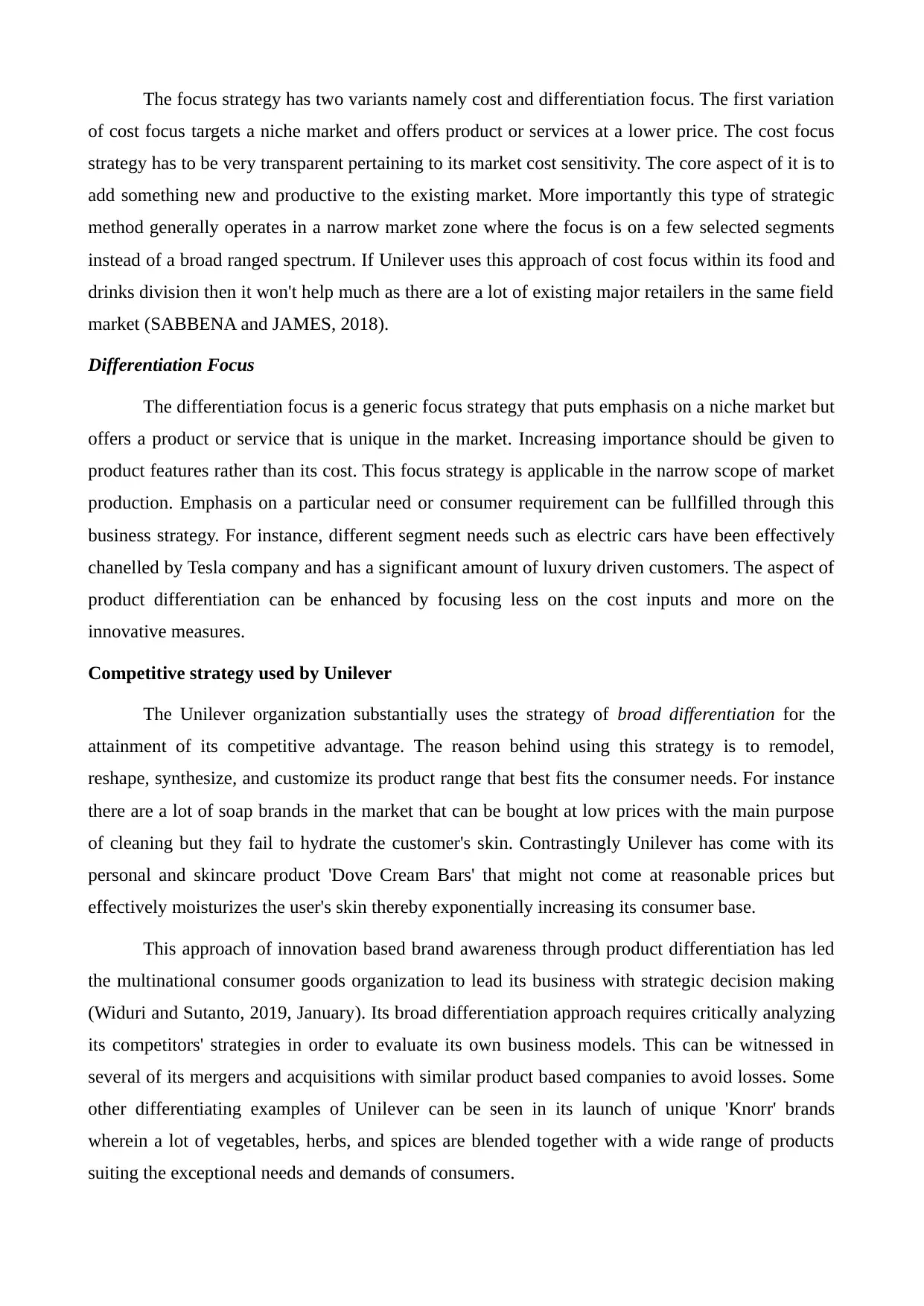
The focus strategy has two variants namely cost and differentiation focus. The first variation
of cost focus targets a niche market and offers product or services at a lower price. The cost focus
strategy has to be very transparent pertaining to its market cost sensitivity. The core aspect of it is to
add something new and productive to the existing market. More importantly this type of strategic
method generally operates in a narrow market zone where the focus is on a few selected segments
instead of a broad ranged spectrum. If Unilever uses this approach of cost focus within its food and
drinks division then it won't help much as there are a lot of existing major retailers in the same field
market (SABBENA and JAMES, 2018).
Differentiation Focus
The differentiation focus is a generic focus strategy that puts emphasis on a niche market but
offers a product or service that is unique in the market. Increasing importance should be given to
product features rather than its cost. This focus strategy is applicable in the narrow scope of market
production. Emphasis on a particular need or consumer requirement can be fullfilled through this
business strategy. For instance, different segment needs such as electric cars have been effectively
chanelled by Tesla company and has a significant amount of luxury driven customers. The aspect of
product differentiation can be enhanced by focusing less on the cost inputs and more on the
innovative measures.
Competitive strategy used by Unilever
The Unilever organization substantially uses the strategy of broad differentiation for the
attainment of its competitive advantage. The reason behind using this strategy is to remodel,
reshape, synthesize, and customize its product range that best fits the consumer needs. For instance
there are a lot of soap brands in the market that can be bought at low prices with the main purpose
of cleaning but they fail to hydrate the customer's skin. Contrastingly Unilever has come with its
personal and skincare product 'Dove Cream Bars' that might not come at reasonable prices but
effectively moisturizes the user's skin thereby exponentially increasing its consumer base.
This approach of innovation based brand awareness through product differentiation has led
the multinational consumer goods organization to lead its business with strategic decision making
(Widuri and Sutanto, 2019, January). Its broad differentiation approach requires critically analyzing
its competitors' strategies in order to evaluate its own business models. This can be witnessed in
several of its mergers and acquisitions with similar product based companies to avoid losses. Some
other differentiating examples of Unilever can be seen in its launch of unique 'Knorr' brands
wherein a lot of vegetables, herbs, and spices are blended together with a wide range of products
suiting the exceptional needs and demands of consumers.
of cost focus targets a niche market and offers product or services at a lower price. The cost focus
strategy has to be very transparent pertaining to its market cost sensitivity. The core aspect of it is to
add something new and productive to the existing market. More importantly this type of strategic
method generally operates in a narrow market zone where the focus is on a few selected segments
instead of a broad ranged spectrum. If Unilever uses this approach of cost focus within its food and
drinks division then it won't help much as there are a lot of existing major retailers in the same field
market (SABBENA and JAMES, 2018).
Differentiation Focus
The differentiation focus is a generic focus strategy that puts emphasis on a niche market but
offers a product or service that is unique in the market. Increasing importance should be given to
product features rather than its cost. This focus strategy is applicable in the narrow scope of market
production. Emphasis on a particular need or consumer requirement can be fullfilled through this
business strategy. For instance, different segment needs such as electric cars have been effectively
chanelled by Tesla company and has a significant amount of luxury driven customers. The aspect of
product differentiation can be enhanced by focusing less on the cost inputs and more on the
innovative measures.
Competitive strategy used by Unilever
The Unilever organization substantially uses the strategy of broad differentiation for the
attainment of its competitive advantage. The reason behind using this strategy is to remodel,
reshape, synthesize, and customize its product range that best fits the consumer needs. For instance
there are a lot of soap brands in the market that can be bought at low prices with the main purpose
of cleaning but they fail to hydrate the customer's skin. Contrastingly Unilever has come with its
personal and skincare product 'Dove Cream Bars' that might not come at reasonable prices but
effectively moisturizes the user's skin thereby exponentially increasing its consumer base.
This approach of innovation based brand awareness through product differentiation has led
the multinational consumer goods organization to lead its business with strategic decision making
(Widuri and Sutanto, 2019, January). Its broad differentiation approach requires critically analyzing
its competitors' strategies in order to evaluate its own business models. This can be witnessed in
several of its mergers and acquisitions with similar product based companies to avoid losses. Some
other differentiating examples of Unilever can be seen in its launch of unique 'Knorr' brands
wherein a lot of vegetables, herbs, and spices are blended together with a wide range of products
suiting the exceptional needs and demands of consumers.
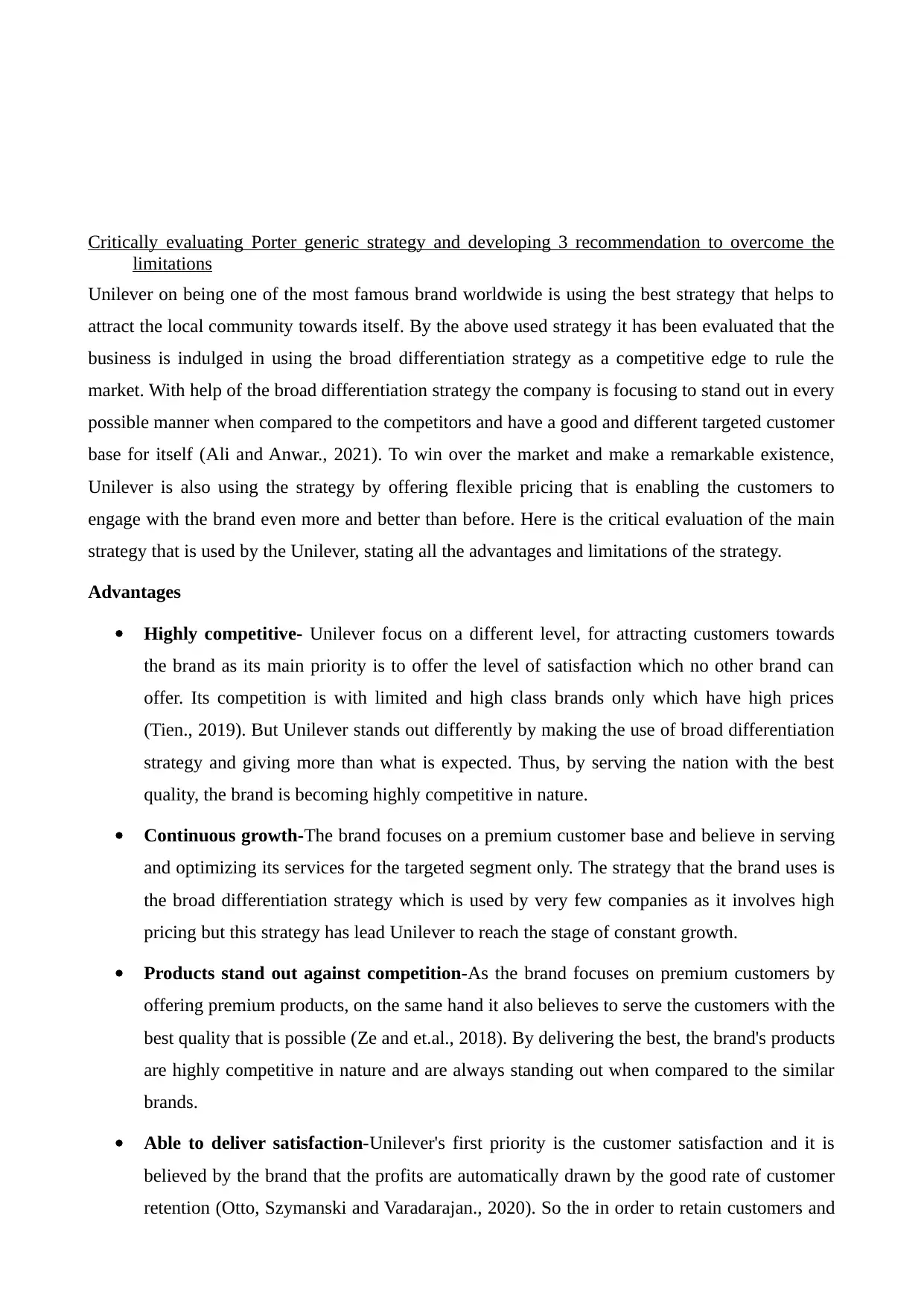
Critically evaluating Porter generic strategy and developing 3 recommendation to overcome the
limitations
Unilever on being one of the most famous brand worldwide is using the best strategy that helps to
attract the local community towards itself. By the above used strategy it has been evaluated that the
business is indulged in using the broad differentiation strategy as a competitive edge to rule the
market. With help of the broad differentiation strategy the company is focusing to stand out in every
possible manner when compared to the competitors and have a good and different targeted customer
base for itself (Ali and Anwar., 2021). To win over the market and make a remarkable existence,
Unilever is also using the strategy by offering flexible pricing that is enabling the customers to
engage with the brand even more and better than before. Here is the critical evaluation of the main
strategy that is used by the Unilever, stating all the advantages and limitations of the strategy.
Advantages
Highly competitive- Unilever focus on a different level, for attracting customers towards
the brand as its main priority is to offer the level of satisfaction which no other brand can
offer. Its competition is with limited and high class brands only which have high prices
(Tien., 2019). But Unilever stands out differently by making the use of broad differentiation
strategy and giving more than what is expected. Thus, by serving the nation with the best
quality, the brand is becoming highly competitive in nature.
Continuous growth-The brand focuses on a premium customer base and believe in serving
and optimizing its services for the targeted segment only. The strategy that the brand uses is
the broad differentiation strategy which is used by very few companies as it involves high
pricing but this strategy has lead Unilever to reach the stage of constant growth.
Products stand out against competition-As the brand focuses on premium customers by
offering premium products, on the same hand it also believes to serve the customers with the
best quality that is possible (Ze and et.al., 2018). By delivering the best, the brand's products
are highly competitive in nature and are always standing out when compared to the similar
brands.
Able to deliver satisfaction-Unilever's first priority is the customer satisfaction and it is
believed by the brand that the profits are automatically drawn by the good rate of customer
retention (Otto, Szymanski and Varadarajan., 2020). So the in order to retain customers and
limitations
Unilever on being one of the most famous brand worldwide is using the best strategy that helps to
attract the local community towards itself. By the above used strategy it has been evaluated that the
business is indulged in using the broad differentiation strategy as a competitive edge to rule the
market. With help of the broad differentiation strategy the company is focusing to stand out in every
possible manner when compared to the competitors and have a good and different targeted customer
base for itself (Ali and Anwar., 2021). To win over the market and make a remarkable existence,
Unilever is also using the strategy by offering flexible pricing that is enabling the customers to
engage with the brand even more and better than before. Here is the critical evaluation of the main
strategy that is used by the Unilever, stating all the advantages and limitations of the strategy.
Advantages
Highly competitive- Unilever focus on a different level, for attracting customers towards
the brand as its main priority is to offer the level of satisfaction which no other brand can
offer. Its competition is with limited and high class brands only which have high prices
(Tien., 2019). But Unilever stands out differently by making the use of broad differentiation
strategy and giving more than what is expected. Thus, by serving the nation with the best
quality, the brand is becoming highly competitive in nature.
Continuous growth-The brand focuses on a premium customer base and believe in serving
and optimizing its services for the targeted segment only. The strategy that the brand uses is
the broad differentiation strategy which is used by very few companies as it involves high
pricing but this strategy has lead Unilever to reach the stage of constant growth.
Products stand out against competition-As the brand focuses on premium customers by
offering premium products, on the same hand it also believes to serve the customers with the
best quality that is possible (Ze and et.al., 2018). By delivering the best, the brand's products
are highly competitive in nature and are always standing out when compared to the similar
brands.
Able to deliver satisfaction-Unilever's first priority is the customer satisfaction and it is
believed by the brand that the profits are automatically drawn by the good rate of customer
retention (Otto, Szymanski and Varadarajan., 2020). So the in order to retain customers and
⊘ This is a preview!⊘
Do you want full access?
Subscribe today to unlock all pages.

Trusted by 1+ million students worldwide
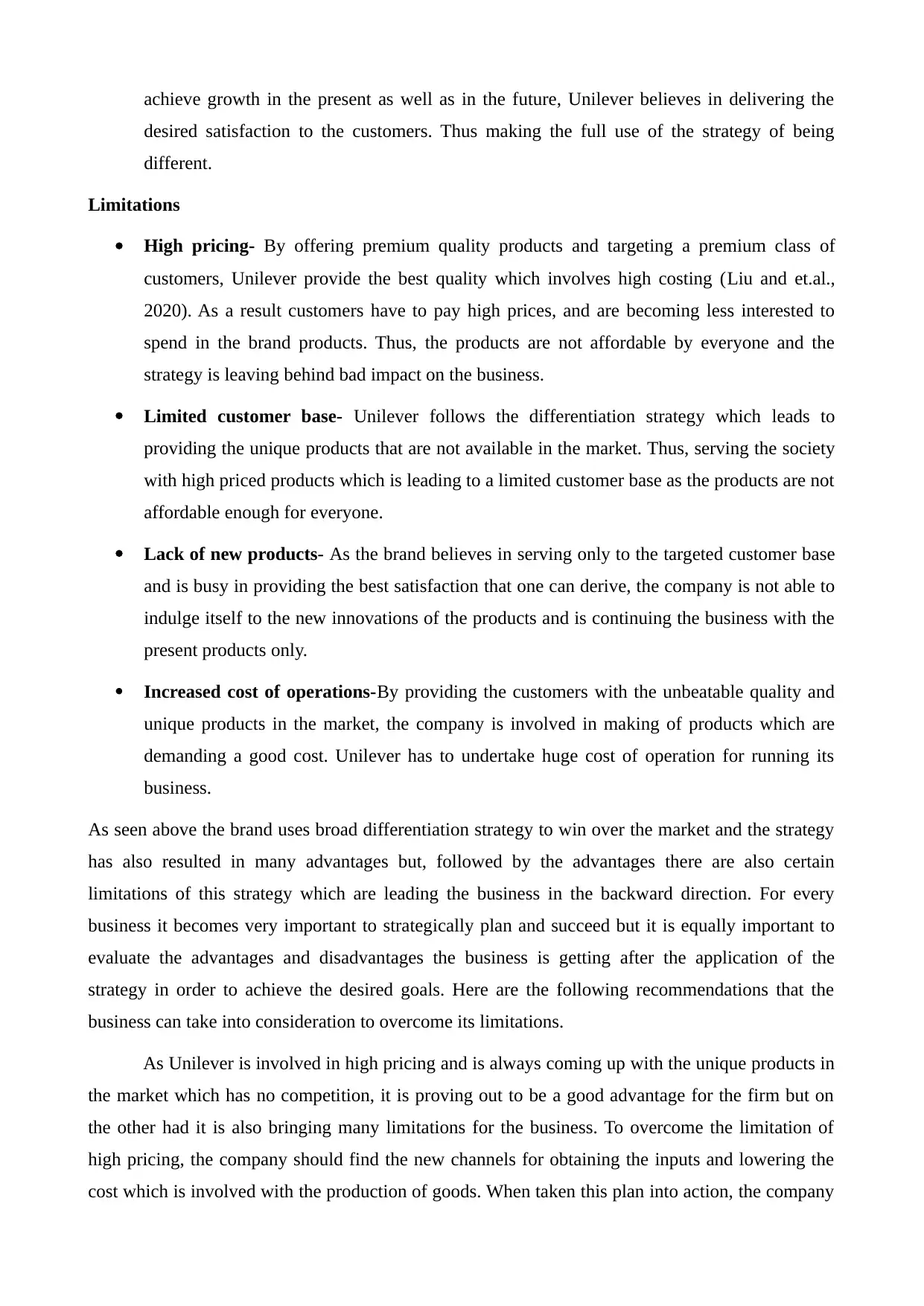
achieve growth in the present as well as in the future, Unilever believes in delivering the
desired satisfaction to the customers. Thus making the full use of the strategy of being
different.
Limitations
High pricing- By offering premium quality products and targeting a premium class of
customers, Unilever provide the best quality which involves high costing (Liu and et.al.,
2020). As a result customers have to pay high prices, and are becoming less interested to
spend in the brand products. Thus, the products are not affordable by everyone and the
strategy is leaving behind bad impact on the business.
Limited customer base- Unilever follows the differentiation strategy which leads to
providing the unique products that are not available in the market. Thus, serving the society
with high priced products which is leading to a limited customer base as the products are not
affordable enough for everyone.
Lack of new products- As the brand believes in serving only to the targeted customer base
and is busy in providing the best satisfaction that one can derive, the company is not able to
indulge itself to the new innovations of the products and is continuing the business with the
present products only.
Increased cost of operations-By providing the customers with the unbeatable quality and
unique products in the market, the company is involved in making of products which are
demanding a good cost. Unilever has to undertake huge cost of operation for running its
business.
As seen above the brand uses broad differentiation strategy to win over the market and the strategy
has also resulted in many advantages but, followed by the advantages there are also certain
limitations of this strategy which are leading the business in the backward direction. For every
business it becomes very important to strategically plan and succeed but it is equally important to
evaluate the advantages and disadvantages the business is getting after the application of the
strategy in order to achieve the desired goals. Here are the following recommendations that the
business can take into consideration to overcome its limitations.
As Unilever is involved in high pricing and is always coming up with the unique products in
the market which has no competition, it is proving out to be a good advantage for the firm but on
the other had it is also bringing many limitations for the business. To overcome the limitation of
high pricing, the company should find the new channels for obtaining the inputs and lowering the
cost which is involved with the production of goods. When taken this plan into action, the company
desired satisfaction to the customers. Thus making the full use of the strategy of being
different.
Limitations
High pricing- By offering premium quality products and targeting a premium class of
customers, Unilever provide the best quality which involves high costing (Liu and et.al.,
2020). As a result customers have to pay high prices, and are becoming less interested to
spend in the brand products. Thus, the products are not affordable by everyone and the
strategy is leaving behind bad impact on the business.
Limited customer base- Unilever follows the differentiation strategy which leads to
providing the unique products that are not available in the market. Thus, serving the society
with high priced products which is leading to a limited customer base as the products are not
affordable enough for everyone.
Lack of new products- As the brand believes in serving only to the targeted customer base
and is busy in providing the best satisfaction that one can derive, the company is not able to
indulge itself to the new innovations of the products and is continuing the business with the
present products only.
Increased cost of operations-By providing the customers with the unbeatable quality and
unique products in the market, the company is involved in making of products which are
demanding a good cost. Unilever has to undertake huge cost of operation for running its
business.
As seen above the brand uses broad differentiation strategy to win over the market and the strategy
has also resulted in many advantages but, followed by the advantages there are also certain
limitations of this strategy which are leading the business in the backward direction. For every
business it becomes very important to strategically plan and succeed but it is equally important to
evaluate the advantages and disadvantages the business is getting after the application of the
strategy in order to achieve the desired goals. Here are the following recommendations that the
business can take into consideration to overcome its limitations.
As Unilever is involved in high pricing and is always coming up with the unique products in
the market which has no competition, it is proving out to be a good advantage for the firm but on
the other had it is also bringing many limitations for the business. To overcome the limitation of
high pricing, the company should find the new channels for obtaining the inputs and lowering the
cost which is involved with the production of goods. When taken this plan into action, the company
Paraphrase This Document
Need a fresh take? Get an instant paraphrase of this document with our AI Paraphraser
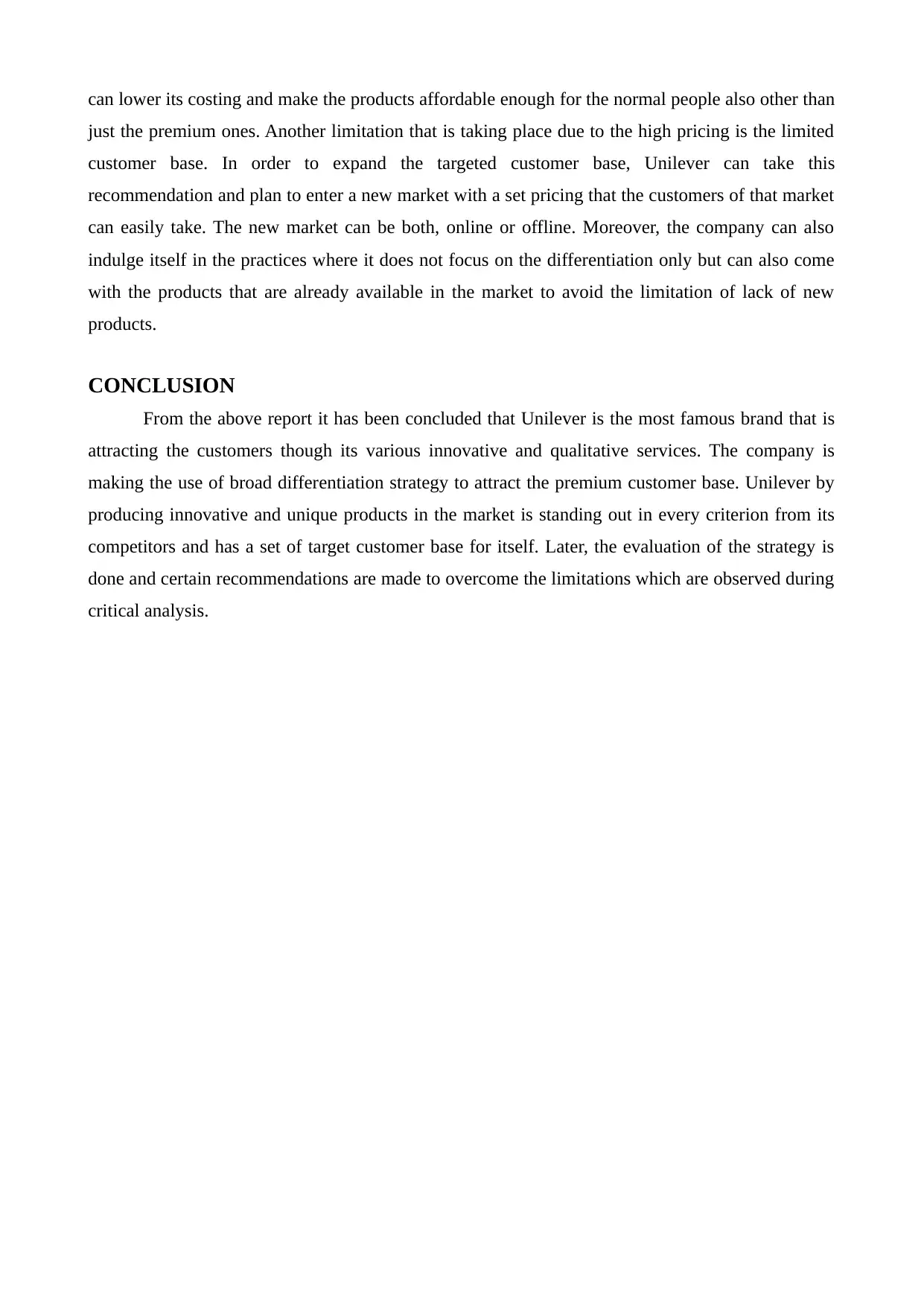
can lower its costing and make the products affordable enough for the normal people also other than
just the premium ones. Another limitation that is taking place due to the high pricing is the limited
customer base. In order to expand the targeted customer base, Unilever can take this
recommendation and plan to enter a new market with a set pricing that the customers of that market
can easily take. The new market can be both, online or offline. Moreover, the company can also
indulge itself in the practices where it does not focus on the differentiation only but can also come
with the products that are already available in the market to avoid the limitation of lack of new
products.
CONCLUSION
From the above report it has been concluded that Unilever is the most famous brand that is
attracting the customers though its various innovative and qualitative services. The company is
making the use of broad differentiation strategy to attract the premium customer base. Unilever by
producing innovative and unique products in the market is standing out in every criterion from its
competitors and has a set of target customer base for itself. Later, the evaluation of the strategy is
done and certain recommendations are made to overcome the limitations which are observed during
critical analysis.
just the premium ones. Another limitation that is taking place due to the high pricing is the limited
customer base. In order to expand the targeted customer base, Unilever can take this
recommendation and plan to enter a new market with a set pricing that the customers of that market
can easily take. The new market can be both, online or offline. Moreover, the company can also
indulge itself in the practices where it does not focus on the differentiation only but can also come
with the products that are already available in the market to avoid the limitation of lack of new
products.
CONCLUSION
From the above report it has been concluded that Unilever is the most famous brand that is
attracting the customers though its various innovative and qualitative services. The company is
making the use of broad differentiation strategy to attract the premium customer base. Unilever by
producing innovative and unique products in the market is standing out in every criterion from its
competitors and has a set of target customer base for itself. Later, the evaluation of the strategy is
done and certain recommendations are made to overcome the limitations which are observed during
critical analysis.
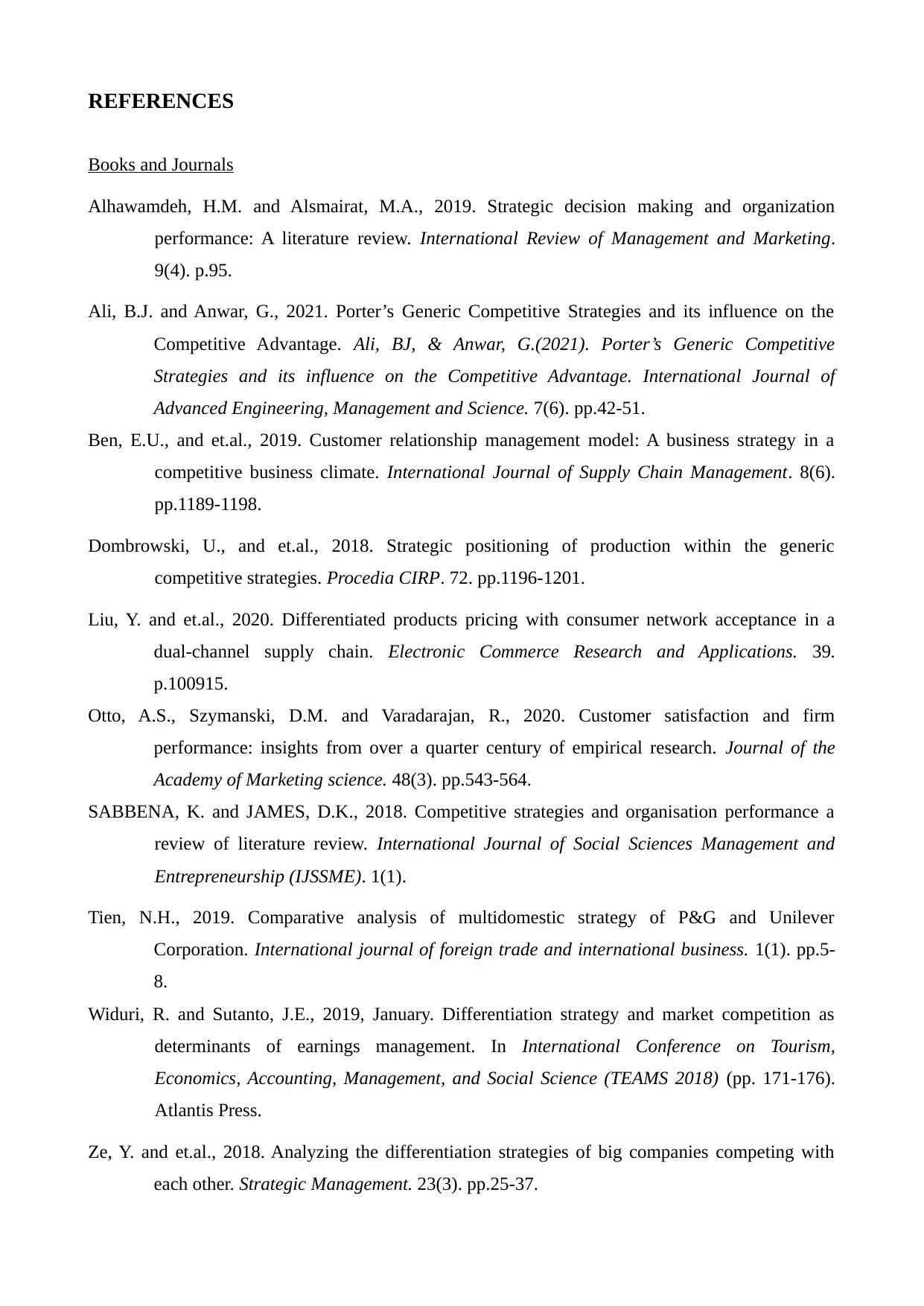
REFERENCES
Books and Journals
Alhawamdeh, H.M. and Alsmairat, M.A., 2019. Strategic decision making and organization
performance: A literature review. International Review of Management and Marketing.
9(4). p.95.
Ali, B.J. and Anwar, G., 2021. Porter’s Generic Competitive Strategies and its influence on the
Competitive Advantage. Ali, BJ, & Anwar, G.(2021). Porter’s Generic Competitive
Strategies and its influence on the Competitive Advantage. International Journal of
Advanced Engineering, Management and Science. 7(6). pp.42-51.
Ben, E.U., and et.al., 2019. Customer relationship management model: A business strategy in a
competitive business climate. International Journal of Supply Chain Management. 8(6).
pp.1189-1198.
Dombrowski, U., and et.al., 2018. Strategic positioning of production within the generic
competitive strategies. Procedia CIRP. 72. pp.1196-1201.
Liu, Y. and et.al., 2020. Differentiated products pricing with consumer network acceptance in a
dual-channel supply chain. Electronic Commerce Research and Applications. 39.
p.100915.
Otto, A.S., Szymanski, D.M. and Varadarajan, R., 2020. Customer satisfaction and firm
performance: insights from over a quarter century of empirical research. Journal of the
Academy of Marketing science. 48(3). pp.543-564.
SABBENA, K. and JAMES, D.K., 2018. Competitive strategies and organisation performance a
review of literature review. International Journal of Social Sciences Management and
Entrepreneurship (IJSSME). 1(1).
Tien, N.H., 2019. Comparative analysis of multidomestic strategy of P&G and Unilever
Corporation. International journal of foreign trade and international business. 1(1). pp.5-
8.
Widuri, R. and Sutanto, J.E., 2019, January. Differentiation strategy and market competition as
determinants of earnings management. In International Conference on Tourism,
Economics, Accounting, Management, and Social Science (TEAMS 2018) (pp. 171-176).
Atlantis Press.
Ze, Y. and et.al., 2018. Analyzing the differentiation strategies of big companies competing with
each other. Strategic Management. 23(3). pp.25-37.
Books and Journals
Alhawamdeh, H.M. and Alsmairat, M.A., 2019. Strategic decision making and organization
performance: A literature review. International Review of Management and Marketing.
9(4). p.95.
Ali, B.J. and Anwar, G., 2021. Porter’s Generic Competitive Strategies and its influence on the
Competitive Advantage. Ali, BJ, & Anwar, G.(2021). Porter’s Generic Competitive
Strategies and its influence on the Competitive Advantage. International Journal of
Advanced Engineering, Management and Science. 7(6). pp.42-51.
Ben, E.U., and et.al., 2019. Customer relationship management model: A business strategy in a
competitive business climate. International Journal of Supply Chain Management. 8(6).
pp.1189-1198.
Dombrowski, U., and et.al., 2018. Strategic positioning of production within the generic
competitive strategies. Procedia CIRP. 72. pp.1196-1201.
Liu, Y. and et.al., 2020. Differentiated products pricing with consumer network acceptance in a
dual-channel supply chain. Electronic Commerce Research and Applications. 39.
p.100915.
Otto, A.S., Szymanski, D.M. and Varadarajan, R., 2020. Customer satisfaction and firm
performance: insights from over a quarter century of empirical research. Journal of the
Academy of Marketing science. 48(3). pp.543-564.
SABBENA, K. and JAMES, D.K., 2018. Competitive strategies and organisation performance a
review of literature review. International Journal of Social Sciences Management and
Entrepreneurship (IJSSME). 1(1).
Tien, N.H., 2019. Comparative analysis of multidomestic strategy of P&G and Unilever
Corporation. International journal of foreign trade and international business. 1(1). pp.5-
8.
Widuri, R. and Sutanto, J.E., 2019, January. Differentiation strategy and market competition as
determinants of earnings management. In International Conference on Tourism,
Economics, Accounting, Management, and Social Science (TEAMS 2018) (pp. 171-176).
Atlantis Press.
Ze, Y. and et.al., 2018. Analyzing the differentiation strategies of big companies competing with
each other. Strategic Management. 23(3). pp.25-37.
⊘ This is a preview!⊘
Do you want full access?
Subscribe today to unlock all pages.

Trusted by 1+ million students worldwide
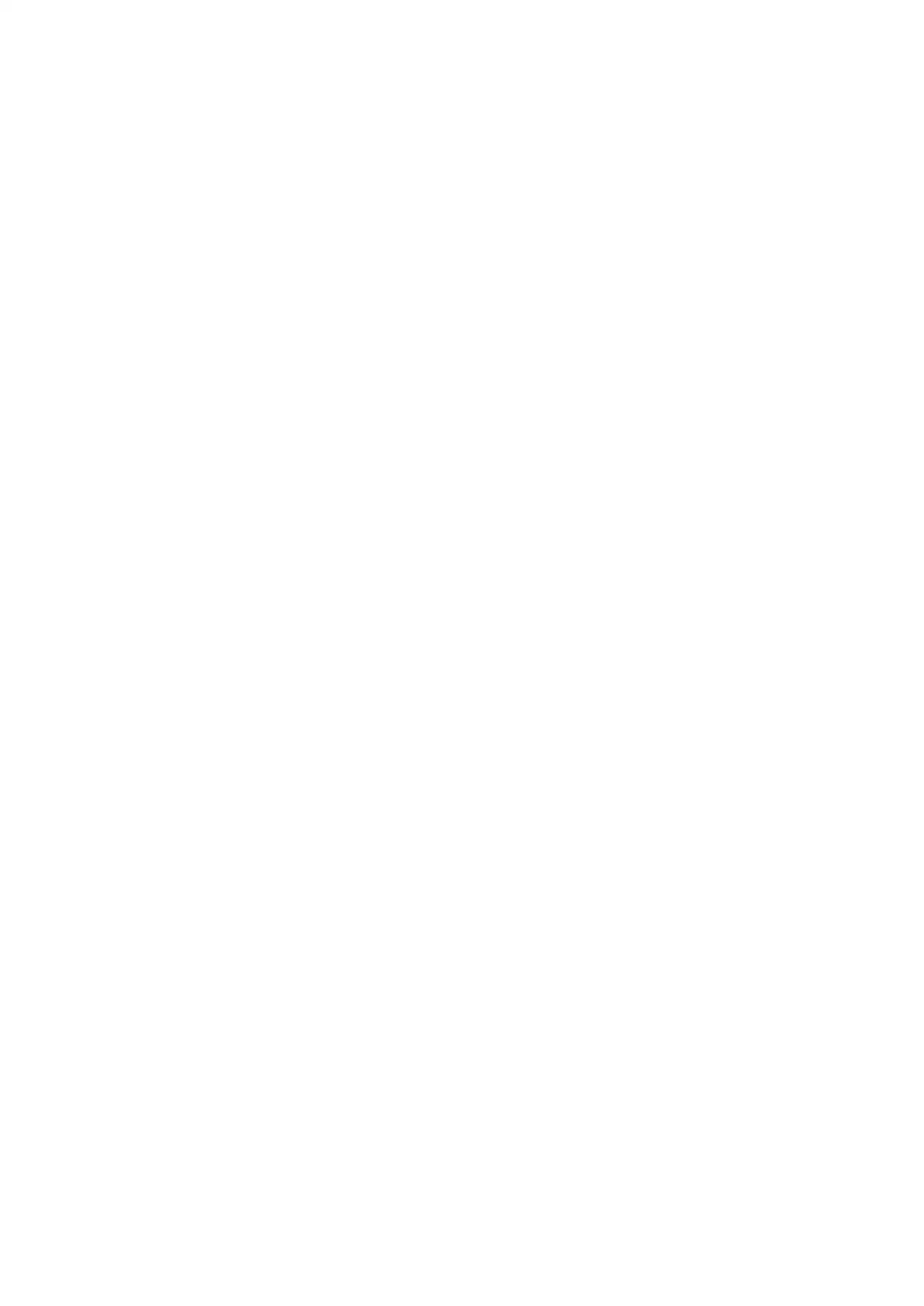
1 out of 10
Related Documents
Your All-in-One AI-Powered Toolkit for Academic Success.
+13062052269
info@desklib.com
Available 24*7 on WhatsApp / Email
![[object Object]](/_next/static/media/star-bottom.7253800d.svg)
Unlock your academic potential
Copyright © 2020–2025 A2Z Services. All Rights Reserved. Developed and managed by ZUCOL.





